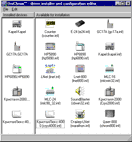Configuration editor of UniChrom (tm)

Unique driver collection, extreme installation simplicity.
JUST DRAG'N'DROP DRIVER YOU NEED
Drivers was made using unified interface developed by NAS Ltd.
There is possibility to create driver for any type
of GC, HPLC, ADC equipment.
There is great connection possibility for unifying laboratory
interface and making instrument incorporation easier.
Driver Data Link
Driver is connected to chromatography instrument over digital
interface. The Data link layer is a software component that makes
possible instrument to driver interaction regardless of physical
connection type. Many people have heard about OSI/ISO reference
model. In terms of this model driver data link is a transport
level.
Now data link layer allows three different type of software to
instrument connection:
- Serial Data Link. Wellknown RS-232 interface and all looking alike - RS-485, 422. The driver use this connection by default, and looks over first 4 comm ports while autodetecting devices. For example if you need a connection on non-standard comm port named COM15, then you should specify in configuration editor parameter ComName equal to COM15
- HPIB Data Link. When the computer has HPIOLIBS package installed and working and dynalink sicl32.dll is present on the system, then specifying ComName in style: hpib7,15 would open hpib session between device with id 15 and controller id 7.
- TCP/IP Data Link. This style of connection requires that you specify parameter ComName in style: tcp:a.b.c.d:p, where a.b.c.d - decimal IP address representation (e.g. 192.168.100.1) of host/instrument you want to connect, p is a TCP port number of host/instrument. Obviously you can use ethernet-to-rs converters for placing your instrument as far as you can. Small Linux box with perl program that works like a hub repeating data receiving from RS to opened TCP connection and vice versa can do this job right.
- File Data Link. Is very useful for debugging. Typically we use this option like ComName c:\binlog.dat, where binlog.dat - binary data file recorded somewhere from live instrument.
- USB Data Link - under heavy development.
Instrument Autodetection
Takes place only for RS connection, since it is simpler task and does not consuming much resources either not causing network problems (just imagine network scanning for searching connected instruments). Autodetection is carried even when parameter ComName is set implicitly. Detection results can be ignored specifying IgnoreDetect equal to 1. This means that instrument will be found regardless the detection results.
Instrument configuration
Some gas chromatographic instruments require sensor remapping. For example instrument has 5 flow regulators some of them can be reconnected to different heating zones for different purposes (e.g. split or makeup gases). These instruments support sensor remapping registry parameters. Parameters for sensor remapping look like (I|D)LFN, I - means inlet, D - means detector, L- letter code of corresponding zone A - first , B - second, N - means number of corresponding zone sensor (1..3). Each flow sensor has predefined function for injectors and detectors:
- Carrier gas for inlet or makeup gas for detector.
- Split gas for inlet, hydrogen flow for detector.
- Septum purge flow for inlet, air flow for detector.
Here is an example. Sensor gas 1 is carrier gas for inlet A, sensor 2 is split flow for inlet A, sensor 3 is makeup gas for detector A.
IAF1 = 1, IAF2 = 2, IAF3=0, DAF1=3. Specified 0 means the sensor is turned off.
Some instruments have detector type specification possibility in style D(A|B) is equal to 0..3.
- 0 - no detector at all. E.g. DA = 0. First detector would be hidden.
- 1 - FID detector.
- 2 - TCD detector.